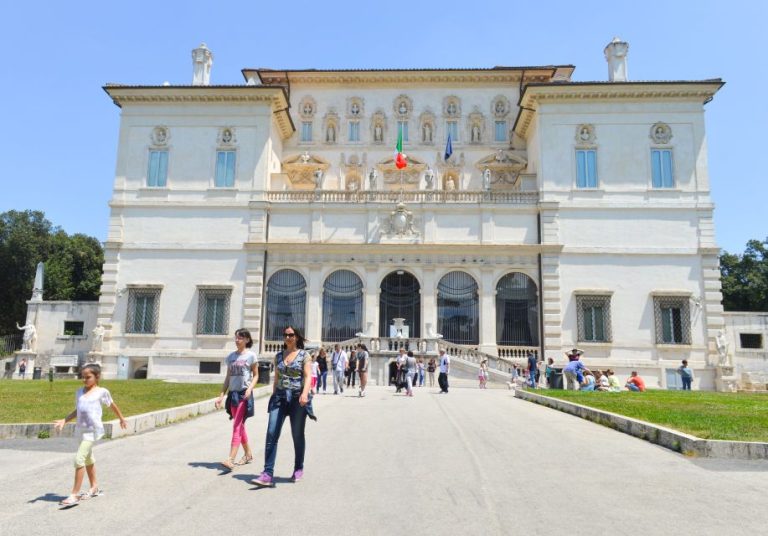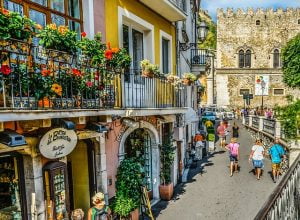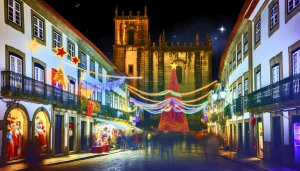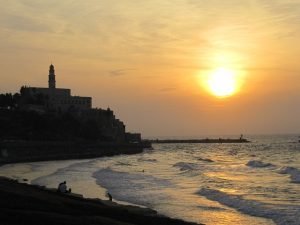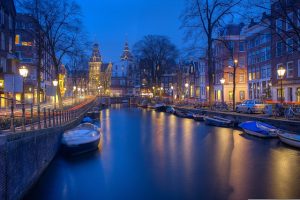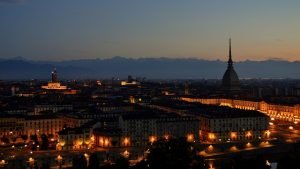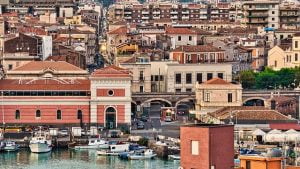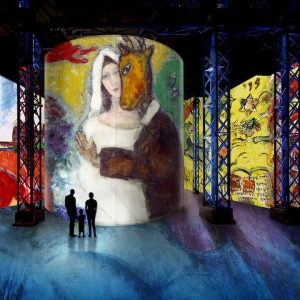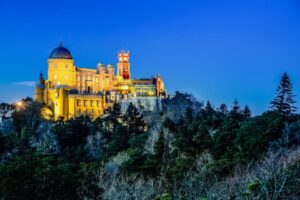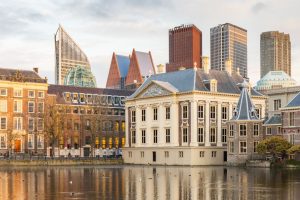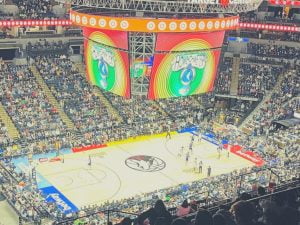When in Rome, it would be a sin to miss one of the most extraordinary artistic and cultural treasures the city has to offer – the Villa Borghese Gallery Museum.
This haven of artistic beauty, hidden in the heart of Rome, contains an amazing array of masterpieces by world-renowned artists and sculptors, all set within beautifully landscaped gardens. As you stroll through the elegant halls, you are transported to another time and place, surrounded by the passion, history and creativity that have left their mark on this celebrated museum.
Our journey through Villa Borghese promises a captivating tour through its amazing art collections, which include renowned masters from different eras; A tour of the museum's magnificent sculpture collections, which sculpted the Roman and Renaissance periods; and a leisurely walk in the well-kept and amazing gardens surrounding the museum. Our guide will also decipher practical details, such as entry fee information and guided tour options, to ensure the ultimate and most memorable Villa Borghese experience. If we expand your horizons beyond the walls of the gallery, we will also delve into the secrets of the Borghese Gardens in Rome, while revealing the captivating historical sites and attractions located in the vicinity.
Villa Borghese Gallery Museum in Rome
Rome, the eternal city, offers a variety of attractions for every type of tourist. Among these landmarks lies the magnificent Villa Borghese Gallery Museum, an absolute must-see for art lovers and history buffs. This extraordinary museum houses a variety of priceless masterpieces and sculptures, wrapped in an oasis of tranquility in the form of its landscaped gardens. A visit to the Villa Borghese Gallery Museum not only provides an insight into Rome's rich artistic heritage, but also transports you to a bygone era of opulence and grandeur.
The Villa Borghese Gallery Museum has its roots in the 17th century, when it was built by the architect Flaminio Ponzio for Cardinal Scipione Borghese. The cardinal, a passionate patron of the arts, commissioned the villa to store his vast collection of art treasures. Over the years, the collection expanded in both size and value as new masterpieces were added by successive generations of the Borghese family. In 1903, the Italian state purchased the villa and its valuable collections from Paz, and turned it into a public museum. Today, the Villa Borghese Gallery Museum stands as a testament to the passion and dedication of its past patrons, offering visitors a glimpse into centuries of artistic excellence.
Upon entering the Villa Borghese Gallery Museum, get ready to embark on an unforgettable journey through the history of art, from ancient Roman remains to magnificent Renaissance paintings. The museum boasts a rare collection of masterpieces by renowned artists such as Caravaggio, Bernini and Titian. Visitors can marvel at the extraordinary beauty and artistry displayed in each piece, reflecting the immense talent and creativity of their creators. In addition to its rich array of paintings, the villa is also home to an amazing collection of sculptures, making it a treasure trove for those intrigued by the art of the past.
But the Villa Borghese Gallery Museum is not just an art showcase; It impresses its visitors with the immense splendor of its surroundings. The beautifully landscaped gardens that surround the museum offer a peaceful escape from the bustling city beyond. The thick vegetation, picturesque fountains and charming paths invite visitors to immerse themselves in a world of peace and natural beauty.
In the following parts we will delve deeper into the fascinating world of the Villa Borghese Gallery Museum, exploring its breathtaking art collections, magnificent sculptures and magical gardens. Join us as we uncover the secrets that make this Roman gem a must-see on your next visit to the Eternal City.
Art collections at the Villa Borghese Museum
The Villa Borghese Museum, also known as the Borghese Gallery, is a paradise for art lovers. The museum boasts an extensive and diverse collection of paintings, sculptures and other works of art from different periods and styles. When you enter the world of Galleria Borghese, you will be amazed by the richness and variety of its art collections, which include some of the most famous masterpieces by famous artists.
One of the outstanding collections of the museum is the extraordinary display of paintings from the Italian Renaissance and Baroque period. Visitors have the opportunity to admire the masterpieces of famous painters such as Caravaggio, Titian and Raphael. One can admire the skill and complexity displayed in Caravaggio's "David with the Head of Goliath", Titian's "Sacred and Sickly Love" and Raphael's "Deposition".
Caravaggio and his works
There are many works by Caravaggio on display at the Villa Borghese museum, including his masterpieces such as "The Sick Young Bacchus", "The Writing of Saint Jerome" and "The Boy with a Basket of Fruit". Each piece presents a different side of the artist and offers a glimpse of his unique style that revolutionized Renaissance art. The play of light and shadow, along with the emotions and expressions captured in each portrait, make Caravaggio's work a true masterpiece.
Decorative art and ancient mosaics
Visitors are dazzled not only by the amazing paintings but also by the decorative arts and ancient mosaics found in the museum. Villa Borghese displays a fascinating array of majolica, porcelain and glassware from both Europe and Asia. In addition, you will find intricate ancient mosaics that demonstrate the skill and craftsmanship of the ancient Romans.
Neoclassical art
The Borghese Gallery also houses an impressive selection of neoclassical art, with paintings and sculptures by Canova, Thorvaldsen and other prominent artists of the period. Among the most famous works on display are Canova's Pauline Bonaparte Conus Victrix and Thorvaldsen's Cupid and Psyche. These dazzling works provide visitors with an opportunity to experience the aesthetic beauty and elegance of the Neoclassical period.
As you explore the various collections at the Villa Borghese Museum, take your time to appreciate the skill, creativity and mastery of the artists whose works reside here. Villa Borghese Hotel truly celebrates the rich history and talent of the art world, providing visitors with an unforgettable experience amidst its breathtaking collections.
Sculptures in the Villa Borghese Museum
The Villa Borghese Museum houses an extensive and diverse collection of captivating sculptures spanning many periods and styles, making it a must-visit destination for art lovers and historians alike. Among the huge variety of sculptures, visitors will find extraordinary works from the ancient Roman period, as well as well-known works from the Renaissance.
To understand the historical and cultural significance of the sculptures, it is essential to appreciate the dedication and skill demonstrated by their master creators. As you explore the different parts of this museum, you will come across works by some of the most famous sculptors such as Gian Lorenzo Bernini, Antonio Canova and Alessandro Allegardi.
The masterpieces of Gian Lorenzo Bernini
Having significantly influenced both sculpture and architecture during the Baroque period, Gian Lorenzo Bernini's artistic mastery is prominently displayed in the Villa Borghese Museum. Some of his most famous works - such as the stunning "Apollo and Daphne", the heartbreaking "Rape of Proserpina" and the intense "David" - are all on display.
The neoclassical art of Antonio Canova
Another central figure in Italian sculpture is Antonio Canova, a key artist in the neoclassical movement. His famous delicate "Pauline Bonaparte Conus Victrix", representing Napoleon Bonaparte's sister as the goddess of love and beauty, is one of the most valuable assets in the Villa Borghese museum.
The sculptural works of Alessandro Allegardi
A striking example of Alessandro Allegardi's work, and testament to the wonderful details seen throughout the sculpture collections, is his bronze relief, "The Meeting of Attila and Pope Leo I". As you explore the museum, be sure to marvel at the incredible intricacy and artistic skill involved in creating these pieces.
As you admire the sculptures, remember to consider the context in which they were created, and the diverse styles they represent. From the dynamic Baroque movement to the harmonious Neoclassical period, the sculptures at the Villa Borghese Museum offer an immersive journey through the progression of art over time.
Whether you want to observe the technical prowess of ancient Roman sculptures or uncover the allegorical layers of Renaissance art, the Villa Borghese Museum is a treasure trove of sculptural masterpieces. As you traverse the various galleries and halls dedicated to these works, take the opportunity to appreciate the beauty and artistry of countless sculptures spanning a multitude of styles and eras. And while you're there, don't forget to visit the other areas within the museum, such as the landscaped gardens and vast art collections mentioned in previous sections.
Well-kept gardens at the Villa Borghese Museum
One of the most alluring aspects of the Villa Borghese Museum is the magical and beautifully landscaped gardens that surround it. These sprawling gardens offer a peaceful retreat from the bustling city of Rome, boasting picturesque views that will leave you in awe. This part will provide an in-depth look at the different sections of the garden, their history, and the importance of a leisurely stroll through them for a complete experience of Villa Borghese.
The gardens of Villa Borghese were designed by the architect Flaminio Ponzio and are characterized by an impressive English garden style. The gardens, with their intricate design and vast vegetation, were initially created in the seventeenth century as a private park for the Borghese family before being opened to the public in 1903. The gardens have been expertly maintained over the years, preserving their natural beauty for generations to enjoy.
Key areas of the landscaped gardens
As you wander through the gardens of Villa Borghese, you will come across many different areas that showcase the varied landscapes and architectural elements. One such area is Giardino del Lago, a delightful lakeside garden that includes a small island adorned with the Temple of Aesculapius, a popular spot for photography and romantic walks. Don't miss the opportunity to rent a rowing boat and experience the lake from a different perspective.
The Secret Gardens, also known as the Giardini Segreti, include two small gardens located between the villa museum and the zoo of the park. Often overlooked by tourists, these gardens feature Italian and French architectural influences, tranquil paths and intricately trimmed hedges, offering an intimate setting for contemplation or relaxation.
Another unique feature of the Villa Borghese Gardens is Pincian Hill, which offers an unrivaled view of Rome. It is a popular vantage point for watching the sunset, enjoying the breathtaking view of the Eternal City bathed in warm, golden light.
Appreciate the peace and the view
To fully appreciate the landscaped gardens at the Villa Borghese Museum, it is highly recommended to take the time to explore them at a leisurely pace, soaking up the peaceful atmosphere they provide. You will marvel at the harmonious combination of natural beauty and artistic design as you stroll through the gardens and discover hidden gems along your journey.
From vibrant flower beds and centuries-old trees to captivating sculptures and architectural gems like fountains and temples, the landscaped gardens of the Villa Borghese Museum provide a multi-sensory experience that will make your visit truly unforgettable. So relax, take your time and indulge in the true essence of these legendary gardens, ensuring an unforgettable visit to Villa Borghese to cherish for a lifetime.
Entrance fees to the Villa Borghese Museum
A visit to the Villa Borghese Gallery Museum in Rome is an enriching experience due to the unique art collections and the beautiful surrounding gardens. However, before you plan your visit, it is important to know the entrance fees and all the discounts available. In this section, we'll provide a thorough breakdown of admission costs and share some handy tips on how to save money while enjoying all that this wonderful museum has to offer.
The standard entrance fee to the Villa Borghese Museum is 15 new shekels (15 NIS) for an adult. EU residents between the ages of 18 and 25 have a reduced fee of NIS 9, while entry is free for EU residents under 18 and 65 and over. Non-EU citizens are not eligible for these discounts and will have to pay the full adult admission price regardless of age.
It is also worth noting that the entrance to the museum is timed, which means that you will need to reserve a specific entry time slot in advance. This is done to manage the number of visitors and ensure a comfortable experience for all guests. Therefore, it is highly recommended to book tickets online before the visit to guarantee a place and avoid any disappointment.
When it comes to saving money on your visit to the Villa Borghese Museum, there are a few strategies to consider. One option is to visit the museum on the first Sunday of the month, when admission is free for all. However, it is worth noting that these days the museum tends to be more crowded, and you may still need to reserve a time slot in advance. Additionally, for those interested in exploring more of Rome's museums and archaeological sites, the Rome Pass may be a good investment. This ticket grants free entry to two participating museums or archaeological sites of your choice, along with discounted entry to others, making it an attractive option for travelers planning to visit multiple attractions in Rome.
In conclusion, the entrance fees to the Villa Borghese Gallery Museum in Rome vary according to your age and residency status. It's important to book a timed entry in advance, and if you're looking to save money, consider visiting on the first Sunday of the month or investing in the Rome Pass. Armed with this information, you can plan your visit to the Villa Borghese Museum and make the most of its art collections, sculptures and landscaped gardens, as discussed in the previous sections.
Guided tours of the Villa Borghese Museum
Visiting the Villa Borghese Museum with a guided tour is an excellent way to fully appreciate and understand the significance of the museum's art collections, sculptures and gardens. This section details the various guided tour options available to those visiting the Villa Borghese Museum and highlights the benefits of each, providing you with the information you need to make your visit an unforgettable experience.
Various guided tour options
The Villa Borghese Museum offers a variety of options for guided tours to suit the needs of different visitors. General tours cover the museum's most important artworks and provide extensive insights into the art, history and culture surrounding them. Special tours, on the other hand, focus on specific aspects of the museum's collections, such as ancient Roman sculptures or works by famous artists such as Caravaggio and Bernini. This allows visitors to tailor their experience based on their interests and preferences.
Language options for guided tours
Understanding the importance of catering to visitors from all over the world, the Villa Borghese Museum offers guided tours in several languages. Usually, the tours are conducted in English, Italian, French, Spanish and German. Other languages may be available upon request, so it is essential to check with the museum what language options are available for the dates you plan to visit.
The advantages of guided tours over self-guided visits
A guided tour enhances your visit to the museum by offering expert insights and interpretations of the extensive art collection. Tour guides are knowledgeable and passionate about the museum's holdings and the rich history of Villa Borghese. Furthermore, they can answer any questions you may have, help you explore and appreciate the intricate details and stories behind the artworks. Conversely, a self-guided visit may miss vital information and context, limiting your understanding and overall experience.
Book guided tours in advance
Due to the high demand for guided tours, it is important to book the tour well in advance to secure your place. This is especially true during the high tourist season, when the museum sees an influx of visitors. Booking online or directly with the Villa Borghese Museum ensures convenience and guaranteed entry. Keep in mind that reservations may be required even if you prefer a self-guided visit due to restrictions on the number of visitors allowed in specific time slots.
In conclusion, guided tours allow visitors to get the most out of their trip to the Villa Borghese Museum. By providing a deeper understanding of the artworks and a personalized experience based on preferences and language options, a guided tour is an investment worth considering for art lovers looking to immerse themselves in the museum's treasures.
Conclusion regarding a trip to the Villa Borghese Gallery Museum in Rome
As we come to the end of our informative exploration of the Villa Borghese Gallery Museum, it's time to highlight the key elements to consider when organizing a trip to this unparalleled destination. The museum boasts a diverse and awe-inspiring collection of art and sculpture, encompassing essential parts of Roman and Renaissance history. A visit to the Villa Borghese Gallery Museum allows tourists to immerse themselves in Italy's rich artistic heritage while experiencing the breathtaking beauty of the landscaped gardens that surround it.
Visitors should set aside enough time to thoroughly explore this prominent landmark, which houses masterpieces by renowned artists such as Caravaggio, Bernini and Titian. It is also important to remember that the Villa Borghese Museum is located within the larger Borghese Gardens, and offers a wide variety of tourist sites and attractions to discover and appreciate during your visit to Rome.
Maximize your experience
To get the most out of your visit, plan ahead and explore the many offerings at the Villa Borghese Museum. Get to know the different art collections, sculptures and different areas of the gardens to ensure you don't miss crucial attractions. Make your experience even more enriching by considering joining a guided tour, which can provide you with a deeper understanding of the historical, cultural and artistic significance of the treasures within.
While guided tours can enhance your experience, it's just as valuable to wander the museum independently. Take the time to admire the intricate details of the sculptures and observe the emotions evoked by the various works of art. Allow yourself to immerse yourself in the peaceful atmosphere of the landscaped gardens, and contemplate the unique insights and incredible beauty that the Villa Borghese Museum has to offer.
Planning your visit
To ensure a smooth visit, familiarize yourself with the entrance fees and any possible discounts or promotions. Remember to check if there are restrictions and limitations, such as a pre-booking requirement or limits on group size. Consider Rome's busy tourist seasons and try to visit at quieter times, if possible, to avoid long lines and crowded places.
In conclusion, a visit to the Villa Borghese Gallery Museum in Rome is a must for art lovers, historians and anyone looking for a deeper understanding of Italy's fascinating past. By considering the tips and insights shared in this guide, you can really make the most of your visit to this extraordinary destination.
Borghese Gardens in Rome - what's there? Tourist sites and attractions
The Borghese Gardens in Rome offer more than a peaceful and tranquil atmosphere for visitors to enjoy. This vast and historic park, which surrounds the Villa Borghese Museum, is also home to many tourist sites and attractions. In this section, we'll explore other favorite attractions within the Borghese Gardens, such as Villa Medici, Galleria Nazionale d'Arte Moderna, and Piazzale Napoleone, including their historical significance and key features.
Villa Medici
The Villa Medici Hotel, located on Pincian Hill, is an exceptional example of a Renaissance villa. Today, it serves as the French Academy in Rome, embracing its rich history that dates back to the 16th century. Originally built by Cardinal Ferdinando de' Medici, this magnificent villa is attributed to architects Annibale Lippi and Bartolomeo Ammannati. The gardens surrounding the Villa Medici feature manicured lawns, ancient Roman statues and fountains. It's worth taking some time to appreciate the cultural heritage of Villa Medici when visiting the Borghese Gardens.
National Gallery of Modern Art
Another significant attraction within the Borghese Gardens is the National Gallery of Modern Art. Opened in 1883, this museum displays the largest collection of modern and contemporary Italian art, with an emphasis on the artistic movements of the 19th and 20th centuries. With over 5,000 works of art, it displays masterpieces by renowned artists such as Giuseppe Felipe de Volpedo, Gino Severini and Amedeo Modigliani. Galleria Nazionale d'Arte Moderna is a must for art lovers who want to explore the fascinating development of modern Italian art.
Piazzale Napoleon
Piazzale Napoleone is a popular panoramic vantage point in the Borghese Gardens, and provides a breathtaking view of Rome's cityscape. The elevated platform allows visitors to enjoy the view of the majestic dome of St. Peter's Basilica, the Altare della Patria and the lush vegetation of the gardens. Piazzale Napoleone is the perfect place to relax and take unforgettable photos from your visit to the Borghese Gardens in Rome.
In conclusion, a visit to the area surrounding the Villa Borghese Museum offers an opportunity to explore these other cultural and historical attractions. Delving into the Villa Medici, the Galleria Nazionale d'Arte Moderna and the amazing views from Piazzale Napoleone deepens the experience and appreciates the wealth and heritage of Rome. Visitors are invited to spend a lot of time soaking up the beauty and wonder of the Villa Borghese Museum and the surrounding picturesque gardens and attractions.
Notable artists and works in the Villa Borghese Gallery Museum
The following table highlights four prominent artists and their amazing works housed in the Villa Borghese Gallery Museum.
| the work of an artist | art | meaning | the time period |
|---|---|---|---|
| Gian Lorenzo Bernini | Apollo and Daphne | 1622-1625 | A masterful baroque sculpture depicting the mythological story of Apollo's pursuit of Daphne. |
| Caravaggio | David with the head of Goliath | 1607 | A powerful example of Caravaggio's chiaroscuro technique, showing the power and emotion of the biblical story. |
| Raphael | Messiah's testimony | 1507 | An expressive portrait of the burial of Jesus, showing Raphael's skill in composition and drawing. |
| Titian | Holy and morbid love | 1514 | A mysterious masterpiece from the Renaissance period, illustrating the dichotomy between sacred love and earthly love through allegorical figures. |
Frequently asked questions about The Villa Borghese Gallery Museum in Rome
Explore some of the most frequently asked questions related to the Villa Borghese Gallery Museum, its art collections, sculptures, gardens, tickets and guided tours.
- What are the most famous works of art in the Villa Borghese Gallery Museum?
Some of the most famous works of art in the museum include, among others, "Apollo and Daphne" by Gian Lorenzo Bernini, "The Deposition" by Raphael, "Holy and Sickly Love" by Titian, and "David with the Head of Goliath" by Caravaggio. - Are there specific days when the entrance fees to the Villa Borghese Museum are reduced or waived?
Yes, on the first Sunday of every month, access to the museum is free for everyone. In addition, reduced entry fees may be available for European citizens under 26 or over 65, as well as for teachers and students. - How much time should I plan to spend at Villa Borghese Gallery Museum and its gardens?
To fully appreciate the museum's collections, sculptures and gardens, it is recommended to allocate at least 3-4 hours to your visit. Guided tours usually last 2-3 hours, after which you can explore the gardens at your leisure. - Is it necessary to book tickets for the Villa Borghese Gallery Museum in advance?
Yes, due to limited visitor capacity, it is highly recommended to book museum tickets in advance. This will ensure the desired time slot and help you avoid waiting in lines. - What are other points of interest near Villa Borghese Gallery Museum in Rome?
Besides the Borghese Gardens, nearby attractions include the Villa Medici, Galleria Nazionale d'Arte Moderna, Piazzale Napoleone and Bioparco di Roma, all within walking distance. Walking distance from the museum. - Are there any restaurants or cafes near The Villa Borghese Gallery Museum?
Yes, there are several restaurants and cafes both inside and around the Borghese Gardens where you can enjoy a meal, coffee or gelato during your visit. Some popular options include Casina Valadier, Ristorante Mirabelle, and La Terrazza Del Pincio.
The benefits of visiting the Villa Borghese Gallery Museum in Rome
Discover some of the key benefits of planning a trip to the Villa Borghese Gallery Museum in Rome:
- Great art collections: Get up close and personal with the works of some of the greatest artists in history, such as Caravaggio, Bernini and Canova.
- historical significance: Immerse yourself in the rich history of Rome and gain a deeper understanding of its cultural significance.
- Beautiful landscaped gardens: Enjoy the peaceful and picturesque surroundings in the gardens surrounding the museum, which provide a true oasis in the bustling city of Rome.
- Guided tour options: choose from a variety Guided tour options which cater to different interests and different language preferences, and improve your museum experience.
- Other attractions nearby: You can explore the surrounding Borghese Gardens and attractions such as the Villa Medici and the Galleria Nazionale d'Arte Moderna for a fuller experience of Rome's artistic heritage.
- Discounts and promotions: Take advantage of the discounts and promotions available for admission, which allow you to save money and still fully enjoy the museum's offerings.
- Very accessible location: The museum and gardens are easily accessible by public transport or on foot, making it a convenient visit during your Rome journey.
- An inspiring atmosphere: Come and experience the museum's unique ability to inspire creativity and appreciation for the arts during your visit.

